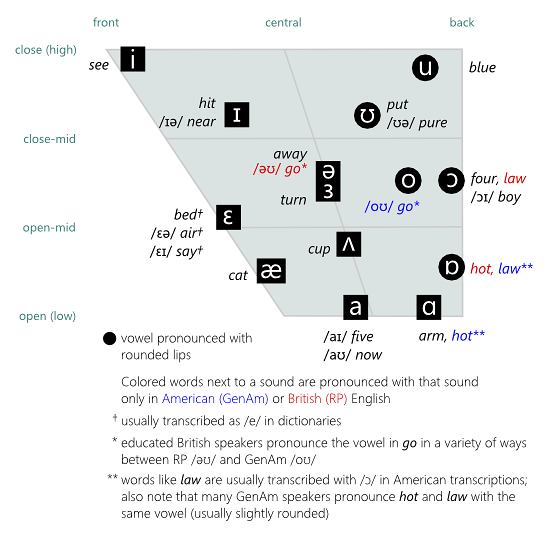English vowel chart

What is this chart?
The above chart shows the pronunciation of English vowels in the American (General American) and British (Received Pronunciation) dialects. The pronunciation is indicated using IPA symbols along three dimensions:
- closeness (how closed or how open the mouth is)
- backness (how far back in the mouth the vowel is articulated)
- roundedness (whether the lips are rounded)
More information on vowel charts can be found in Wikipedia.
Remarks
The chart shows approximate locations of vowels.
You should think of the vowel markers as representing the average pronunciation of a phoneme.
The exact position on the chart depends on the word and the speaker.
For example, /ɔ/ can go almost as high as the close-mid line and almost as low as the open-mid line.
Small differences between British (RP) and American (GenAm) pronunciation
have been ignored for simplicity. For example, the average British /æ/
is slightly more open (more like /a/) than the average American /æ/.
(Remember that there is a lot of variation, so the
average position doesn’t matter so much.)
The symbols used in the chart are taken from the phonemic transcription system used in major learner’s dictionaries and pronunciation dictionaries, such as those published by Longman, Oxford and Cambridge. There are two exceptions:
-
In the chart, the vowel in bed is represented with
/ɛ/. Dictionaries typically transcribe this vowel with/e/. This is misleading becasue the “canonical”/e/in the International Phonetic Alphabet does not stand for the vowel in bed (listen for yourself); it stands for a different vowel that is heard, for example, in the German word See. The closest canonical vowel to the vowel in English bed is/ɛ/.Why do dictionaries follow this misleading convention? For simplicity (
/e/is easier to type than/ɛ/) and for compatibility with earlier works. -
In the chart, the American pronunciation of the vowel in law is represented with
/ɒ/, while the vowel in four is represented with/ɔ/. Dictionaries typically transcribe both law and four with/ɔ/. This is misleading because it suggests:- that four and law have the same vowel in AmE (in contemporary AmE, the vowel in four is more
closed than the vowel in law; in other words, it sounds more like
/u/) -
that the vowel in AmE law is similar to the vowel in BrE law or to the cardinal vowel
/ɔ/(in fact, it is usually more similar to the/ɒ/in British hot and to the cardinal vowel/ɒ/)
The only dictionary which uses the correct symbol
/ɒ/to transcribe law is the excellent Longman Dictionary of Contemporary English (LDOCE). - that four and law have the same vowel in AmE (in contemporary AmE, the vowel in four is more
closed than the vowel in law; in other words, it sounds more like